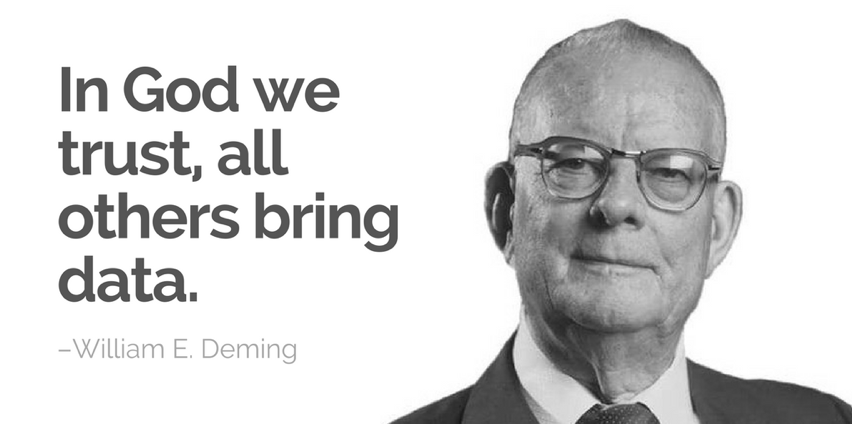As illustrated by the quote below, the case for data in business is not a new one, nor one that needs to be much discussed. The purpose is, and always was, to collect sufficient data (and not too much, ‘infobesity’ and ‘analysis paralysis’ are well-known pitfalls in that area) to make the right choices, with the maximum number of possibilities, whilst acknowledging that decisions are a sort of bet on the future and its uncertainties.

“In God we trust, all others bring data.”
William Edwards Deming, American statistician, professor, author, lecturer, and consultant, best known for the “Plan-Do-Check-Act” cycle
Therefore, the trade-off between the effort to collect and analyze data to build insights and make informed decisions, and the risks incomplete data represents, is still a valid one. It is even more critical in a world that is more and more complex and characterized by VUCA (Volatility, Uncertainty, Complexity, and Ambiguity).
“To the extent that Procurement is a data-driven discipline, we are closely linked to the capabilities of our technology for visibility and insight. And while quality data is an essential foundation for all of Procurement’s efforts, the time required to make it actionable comes with a high opportunity cost. In many cases, we are slave to data cleansing and report creation. Our solutions, despite how they are characterized, often serve as no more than accessible, segmented data storage. Making sure that enabling technologies are doing as much heavy lifting and enrichment as possible frees up Procurement professionals to do the strategic work required to create value and competitive advantage for the organization and colleagues we support.”
Procurement at a crossroads. Jon Hansen and Kelly Barner.
At the same time that the need for more, and better data is becoming more important than ever. Technological capabilities have also evolved to enable organisations to manage the trade-off mentioned better.
“The emergence of intelligent data is reversing procurement’s reliance on looking backward at money spent or supplier past performance. The increased use of ‘big data’, the cloud and analytics enables procurement to work with information, data and models that predict – providing knowledge at your fingertips!”
The Procurement Value Proposition, Gerard Chick, Robert Handfield
Some of the latest technologies represent critical components to building better insights and actionable intelligence:
- IoT = Provides the ability to collect more information (Volume) and in a real-time manner (Velocity & Variability). It is especially true when monitoring physical supply chains (e.g. sensors and geolocation for containers) and evolutions in demands (e.g. sensors in machines for predictive maintenance). It is the foundation for getting data and keeping the Big Data engine running and improving (e.g. Machine Learning).
- Big Data = Presents the capability to consolidate, aggregate, slice… more data coming from multiple sources (Variety), both: internal (e.g. ERPs, or any other information systems) and external (e.g. IoT sensors, 3rd party data providers…).
- Blockchain = Can increase trust (Veracity) in the data collected and stored which is one critical factor in trusting the insights and decisions derived from that data. It also creates a “data backbone” that can be utilised to create interoperability (internally and externally) opening the door to further automation and “interconnections” between physical and financial supply chains.
- AI = Exhibits tremendous computational capacity to analyze massive sets of data to build new knowledge (Value) and continuously learn and improve from new data.
Each of these technologies addresses challenges linked to data management and insight creation from a quantitative and qualitative standpoint, for example, blockchain is a cornerstone of this process. At its core, it stores data (not new, older technologies already do that) in a way that creates more trust in the information. The latter is an essential characteristic of blockchain as a form of digital trust, that has positive consequences on the confidence you can have in your data and what you can do with that data. Also, from an architecture point of view, blockchain fits perfectly with the nature and requirements of the other technologies:
“As Internet of Things applications are by definition distributed it’s only normal that the distributed ledger technology, which blockchain is, will play a role in how devices will communicate directly between each other (keeping a ledger and thus trail of not just devices but also how they interact and, potentially, in which state they are and how they are ‘handled’ in the case of tagged goods).”
Blockchain and the Internet of Things: the IoT blockchain opportunity and challenge, i-SCOOP
To conclude, it is true that technologies like IoT, Big Data, Blockchain, and Artificial Intelligence represent a considerable opportunity for Procurement. Especially for data-related applications. They are the key to better insights and better decisions as they address the “6 Vs.” challenge.
It’s mainly still about the right data, knowledge and insights at the right time for the right purpose and right actions for the right people and outcomes, The underestimated impact of the convergence of AI, IoT and big data, i-SCOOP.
However, before deep diving into what new technologies can do for them and which one to use, organisations need to start the process from a value and outcome perspective. What is the value that the rest of the company and customers expect? What actions would deliver these value components? What information and data drive decisions? Etc…
It is a process that starts from the end (the “why” or meaning) and drill downs to the “how” and then the “what”:
Outcomes (value to business) ➜ Actions ➜ Decisions ➜ Insights ➜ Inputs, factors, and parameters
Only then, can the design of the relevant “system” (people, process, and technology) start and take into account new possibilities of cooperation between humans and machines and the strong need for robust data management processes and governance.
This article is brought to you exclusively by The Business Transformation Network. This is part 2 of a series from Bertrand Maltaverne, Part 1 can be viewed here.





